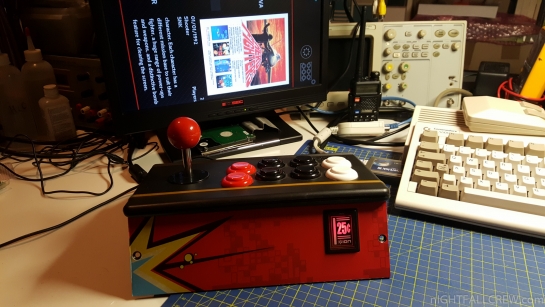
As you can see this is a control pad of the Ion iCade case. It is designed to fit an iPad and has a built in stand for holding it.
The iCade is designed to work as a Bluetooth keyboard of sorts with an iPad.
It uses a standard arcade control wiring and is very easy to modify it to work with any interface can convert the signal from Analog to USB, like the PCB of a Logitech Dual Action joypad.
Gallery:
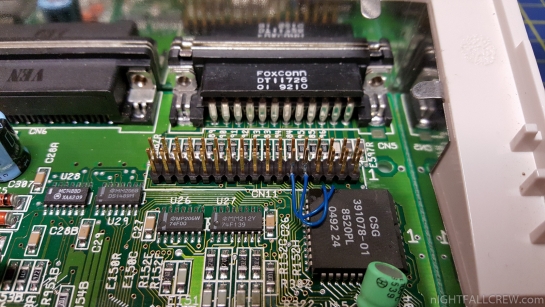
Commodore Amiga 600 – External Floppy Drive as DF0.
This mod is very easy, just follow the schematic attached to this post.
Gallery:
Schematic:

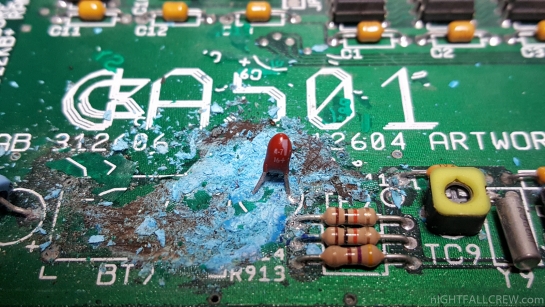
Works that have been made:
- Cleaning the leaked acid (KONTAKT PLCC)
- Sprayed a thin layer of insulating lacquer (DUE-CI V-66)
Gallery:
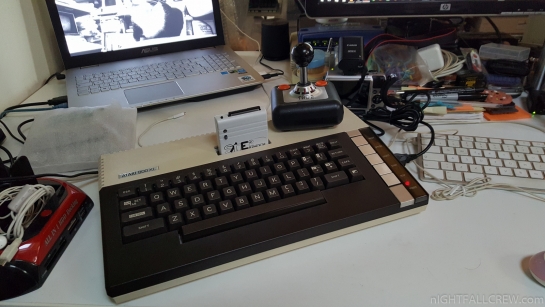
Fortunately a year ago i have also updated the CPLD code (Xilinx) of the Ultimate 1MB to version v2, needed for this update!
Gallery:
source: atariage.com
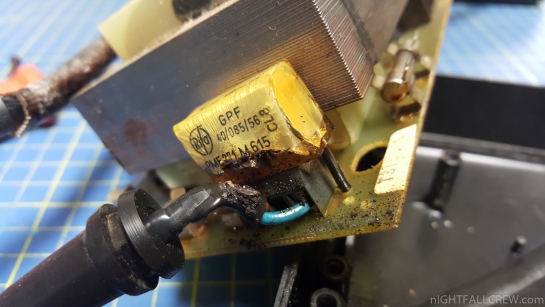
2 x Texas Instruments TI-99/4 Power Supply Fixed
- Removed the RIFA Filter Capacitor, one exploded.
Gallery:
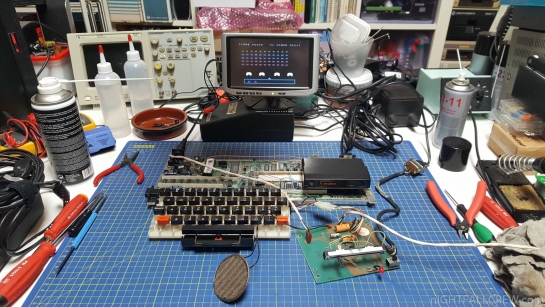
Texas Instruments TI-99/4 Fixed
Defect:
- Garbage screen on startup immediatly or after a couple of minutes.
Fix:
- This defect is very similar to the one of the Coleco Vision console.
The problem are the pins oxidized of the power switch, i have sprayed R-11 and the problem it’s disappeared completely.
I left turned on the computer for more than 2 hours and i have made a 50 x power cycle (ON/OFF) and the problem is no longer appeared.
Note:
I thought there had to be a VDP RAM problem with a diagnosis made remotely without having the TI-99/4 in the laboratory.
To avoid using the lame RF modulator i have used a standard Commodore 64 composite cable that works very well with a NTSC composite video output.
Gallery:
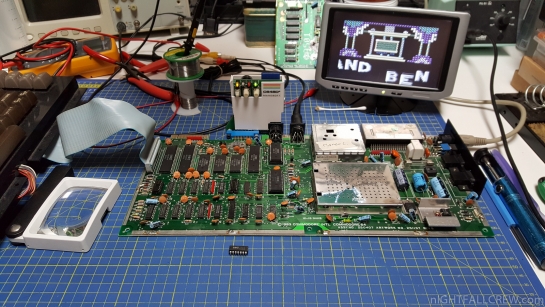
Commodore 64G repaired (1 of 2)
Defect:
Repair:
- Replaced 1 x MOS 7707 (7406) U8
Note:
- The motherboard has been repaired several times, the technician probably in a previous life was a butcher.
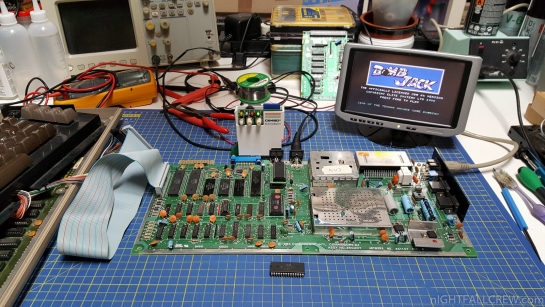
Commodore 64 repaired (2 of 2)
Defect:
- Garbage screen but runs programs perfectly.
Repair:
- Replaced 1 x MOS 906114 (PLA) U17

Apple Computer 1, also known later as the Apple I, or Apple-1, was released by the Apple Computer Company (now Apple Inc.) in 1976. It was designed and hand-built by Steve Wozniak. Wozniak’s friend Steve Jobs had the idea of selling the computer.
The Apple I was Apple’s first product, and to finance its creation, Jobs sold his only means of transportation, a VW Microbus, and Wozniak sold his HP-65 calculator for $500. It was demonstrated in July 1976 at the Homebrew Computer Club in Palo Alto, California.
—————————————————————————————————————————————————
Apple 1 (Mimeo / Mike Willegal Clone) Assembled for a friend of mine; Paolo Cognetti.
Many thanks for the Technical & Moral support to: Piero Todorovich and Alessandro Polito.
I also thank for some electronic components: Gabriele Molesto Zaverio of Museo Dell’informatica Funzionante, Piero Todorovich.
I had several problems with this Apple 1 clone, i very briefly describe the problems below and i attach some photos of the assembling stages.
- 1 – No video image, all voltages are ok.
- 1 + MPS3704 Transistor failure replaced with a 2N3704 pinout not compatible.
- 2 – Garbage screen during boot.
- 2 + Replaced 2 of 7 Shift Register 2504V
- 3 – Keyboard inputs not working, the WOZ monitor is freezed and shows an “@ \” but the “\” does not wrap.
- 3 + Replaced a 27k resistor half broken, probably during transport the capacitor has crushed the resistor.
- 4 – The keyboard does not respond correctly, typing A they print @, typing 1 they print 0 … and so on …
- 4 + Keyboard adapter from Apple II/+ to Apple 1 in short circuit. A wire is skewered in a pin of a Socket.
- 5 – The computer does not respond correctly, but it seems to work. The WOZ monitor responds to commands but does not write to memory and print random locations.
- 5 + Replaced a 7410 which had a pin always at high level.
- 6 – The keyboard has several problems, some switches are completly dead.
- 6 + Replaced switches.
Photos of the assembling stages:
Video:
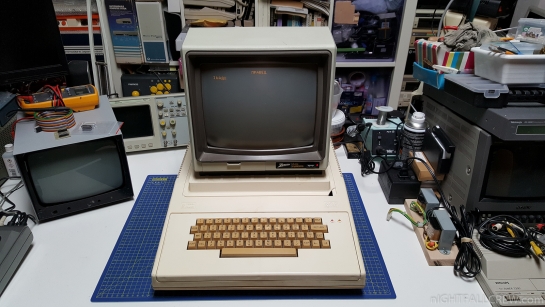
Defect:
- Dead and then Garbage screen.
Components replaced/fixes:
- 1 x CPU 6502 (DH8)
- 1 x RAM MN4164P (DC3)
- One switch of the DIP Switch was in a wrong posistion.
- Fixed the connection of the original lamp (power on led) with the pins cutted.
- Inserted the missing Z80 CPU (DF8)
The keyboard is not working correctly, some keyboard keys are totally dead.
Gallery of the repair:
Pravetz computers
Pravetz (Правец in the original Cyrillic, series 8 and series 16) were Bulgarian computers, manufactured mainly in the town of Pravetz. Some components and software were produced in Stara Zagora, Plovdiv, and other Bulgarian cities.
The first Bulgarian-made personal computer, IMKO-1, was a prototype of the Pravetz computers that were developed by Ivan Vassilev Marangozov, who was often accused of cloning the Apple II. A few early models were produced at the ITKR (pronounced ee-teh-kah-reh, Institute of Technical Cybernetics and Robotics), a section of the Bulgarian Academy of Sciences. Industrial production in Pravetz started shortly after.
Pravetz computers were of major importance in the economy of the Comecon.
In October 2013, a privately held Bulgarian company claimed in their website to have the rights on the trademark and misleadingly announced that “Pravetz Computers are returning to market”. In fact, the company has no link to the original “Pravetz” computers known during the Soviet Era.
Advertisement:
source: wikipedia
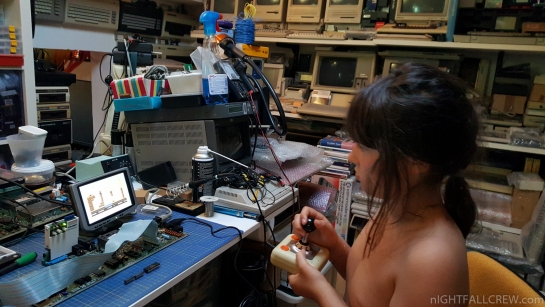
Commodore 64C (ASSY 250469) Repair (1 of 2)
Defect:
- Garbage Screen/Auto Load/Device not Present.
Replaced parts/Fixes:
- 1 x MOS 6526 (U1)
- 2 x Diode 1n4148 (CR9/CR11)
- Rebuilt a pcb track (see photo)
Note:
- As you can see from the photo of the the broken pcb track, evidently someone did a short circuit on the IEC connector on the data lines: SRQin and DATA.
Gallery of the repair:
Commodore 64C (ASSY 250469) Repair (2 of 2)
Defect:
Replaced parts:
- 1 x MOS 8580R5 SID in short circuit (U9)
- 2 x TMS 4464 RAM (U10/U11)
Gallery of the repair:
Commodore 64 (ASSY 250407) Repair (1 of 2)
This Commodore 64 has been already repaired in years past.
Defect:
- Grabage screen/Out of Memory.
Replaced parts:
- 5 x MT 4264-15 RAM (U10/U11/U12/U21/U23)
Gallery of the repair:
Commodore 64 (ASSY 250425) Repair (2 of 2)
Defect:
- Black Screen ..then.. Grabage screen ..then (when hot).. Screen out of Sync
Replaced parts:
- 2 x MT 4264-15 RAM (U11/U23)
- 1 x MOS 901227-03 Kernel ROM (U4)
- 1 x MOS 8701 Clock Generator (U31)
Cleaning Tape and User port connectors.
Gallery of the repair:
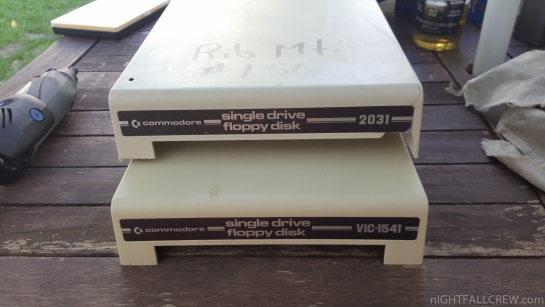
I have sacrificed a Floppy Disk Drive Commodore VIC 1541 to give a new look to a Floppy Disk Drive Commodore 2031 (IEEE-488).
It ‘s not been an easy job, but i’d say the result is very good.
Gallery:
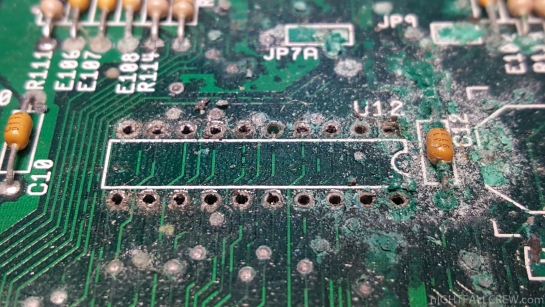
Commodore Amiga 500+ (Battery Acid Leaked) Repair
Defect:
Components replaced and fixes:
- Battery Removed.
- Cleaned the PCB with PCC Kontakt
- Sprayed DUE-CI G-22 on all IC sockets.
- Made ten bridges to restore the traces corroded by the acid of the battery.
- Replaced 1 x 74LS244 (U12)
- Replaced 1 x 74LS373 (U13)
Gallery of the repair:
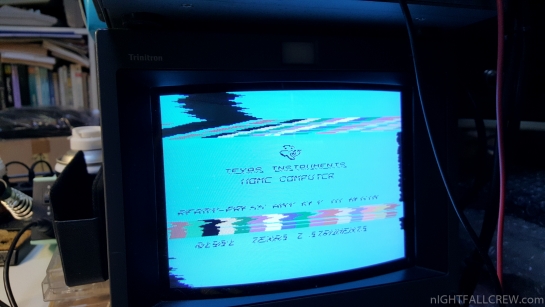
Texas Instruments TI-99/4A Repair (Wave/Raster Lines)
Defect:
- Wave/Raster Lines (see photo).
Replaced parts:
- 1 x Variable Inductor 2 -> 4.5 μH (L100).
Gallery of the repair:
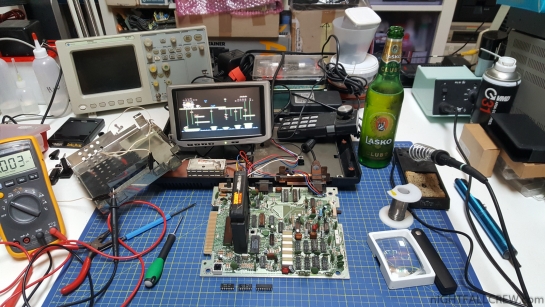
CBS Coleco Vision Repair (Black/Garbage Screen)
Defect:
- Black Screen and then Garbage Screen.
Components replaced:
- 1 x 2114 Static Ram (U4)
- 2 x 4116 Dynamic Ram (U11/U14)
Gallery of the repair:
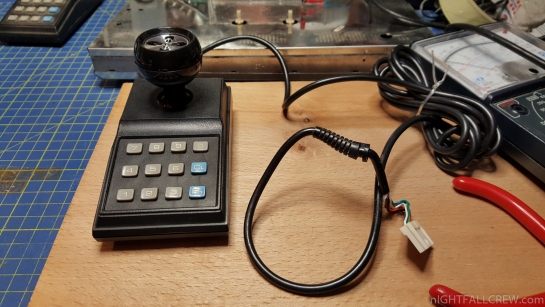
APF Electronics Inc MP-1000 (1978) – Joystick Repair
Defect:
Fix:
- The adhesive tape has dried and the conductive pad move inside the joystick. I have disassembled,cleaned and used a new adhesive tape, now they are like new.
- Replaced the fire button on one of the two joystick completely dead.
Gallery of the repair:














Recent Comments